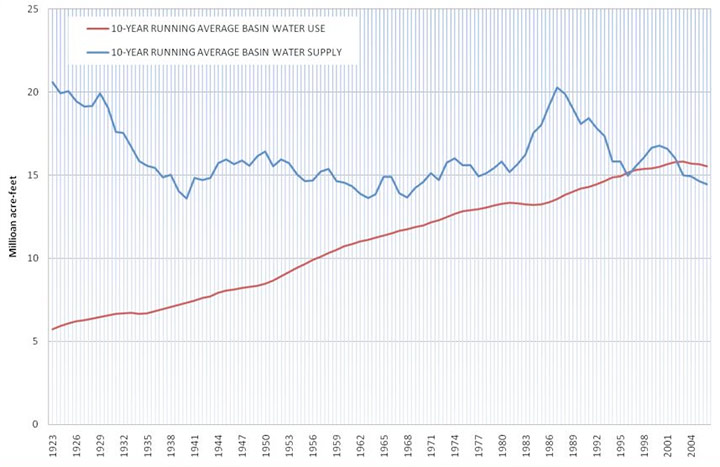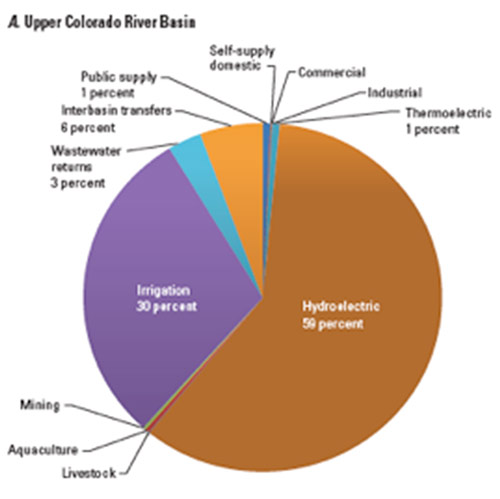Water connects us all, upstream and downstream, past, present and future. It’s up to all of us to conserve and protect it…
— from the Water22.org website
At the start of 2022, the Colorado Water Conservation Board teamed up with Water Education Colorado and the Walton Family Foundation to encourage all of us to take part in solving the water problem.
The problem being, essentially, that people in the American West — and in particular, agricultural businesses and electric companies — want more water than Nature provides.
How to get people to want less? Or at least, how to get them to be more careful about what they use? Those were a couple of the urgent questions the Water ’22 campaign tried to tackle.
From the Water22.org website:
2022 is a milestone year for water in Colorado.
Among others, it is the 100th anniversary of the Colorado River Compact; the 50th anniversary of the Clean Water Act; the 20th anniversary of Water Education Colorado; and the year when the 2015 Colorado Water Plan will be updated to continue our long history of ensuring high quality water to support our state’s wide range of water uses and values.
Using those milestones as a jumping off point, Water ’22 is calling upon all Coloradans to come together to collectively meet the urgency of the moment.
Now that 2022 is nearly over, the 100-year-old Colorado River Compact agreement is slowly falling apart, and the Clean Water Act is under attack from certain politicians in Washington DC.
The ambitious Colorado Water Plan is seven years old, and Colorado’s water problem is arguably worse than ever. That might be due, in part, to external events… but it also might be due, in part, to the fact that the folks who wrote the 2015 Colorado Water Plan tended to look at the water problem through the lens of 1970s water policies.
The American West is not the same place it was in 1970. In 1970, the total amount of water available in the Upper and Lower Basins was around 15 million acre-feet, and the demand from the river was about 12.5 million acre-feet. According to a U.S. Bureau of Reclamation chart (below) the demand exceeded the supply for the first time in 1995.
The Colorado Water Plan is getting an update. The update accepted public input during a 90-day public comment period, from June 30 through September 30, and is expected to be finalized in early 2023. Will the update look at the problem through a new lens?
You can download the draft, here. It’s a huge, 240-page document and may take several minutes to download. If you want the Spanish version, (machine-translated by Google) you can download it here. An equally large document.
Pagosa Springs is mentioned once in the Plan, in a regional context:
The Pagosa Springs-Bayfield-Durango corridor is rapidly growing while experiencing areas of localized water shortages. This area is transitioning from oil and gas, mining, and agriculture to tourism and recreation, and to retirement or second-home communities.
But maybe we’re getting ahead of ourselves. This revised plan will not be finalized until next year.
For the time being, it’s still 2022, and there’s still time to enjoy the water-conserving steps that the Water ’22 organization has been pushing for the past 11 months, in their list of ’22 Ways to Care for Colorado Water in 2022′.
Not all of the 22 recommendations apply to the Pagosa Springs-Bayfield-Durango corridor… but some do. For example:
1. Go to the source – Find out where your water comes from
What river water or groundwater source are you drinking? Find out where your water comes from, and trace its path through the watershed and to your tap. If you receive a water bill, identify your provider and then visit them online to learn where they source your water from.
For most of us who receive a water bill in Pagosa Springs, our water bill comes from Pagosa Area Water and Sanitation District. PAWSD.
Disclosure: I currently serve on the PAWSD Board of Directors, but this editorial series reflects only my personal opinions, and not necessarily the opinions of the PAWSD Board as a whole.
If you water bill comes from PAWSD, you most likely get your water from Lake Hatcher, which is in turn fed mainly by Fourmile Creek via the Dutton Ditch.
If you live east of Piedra Road, however, you likely get your water from the treatment plant on Snowball Road, which is in turn fed through a pipeline that starts near the confluence of the West and East Forks of the San Juan River, near the Mineral County border. (We will be discussing the Snowball Treatment Plant in some detail, in this editorial series.)
If you live in Aspen Springs, one of the largest subdivisions in the state of Colorado, you probably either haul your own water or have it delivered by a private water hauler, from one of the PAWSD fill stations.
Another of the 22 recommendations:
3. Make appliances do the dirty work
Use the dishwasher and washing machine instead of handwashing, and run your appliances only when FULL. Depending on your machines, you can save anywhere from 15-30 gallons per load by filling up and cutting a load.
Maybe I haven’t lived in Colorado long enough, but I’m unfamiliar with the phrase “cutting a load.” I suppose it might mean, “eliminating an unnecessary washer load by waiting until you have a full load of, say, whites or colors.”
But this claim, that you can “save” 15-30 gallons per laundry load has almost no relationship on the actual problem. For most households in western Colorado, for example, the 15-30 gallons of water you use to wash your clothes goes down the drain, into a municipal sewer system, and then into a wastewater treatment plant, from which it gets released back into the overall Colorado River water supply.
When most of us in western Colorado wash clothes, or dishes, or ourselves, we “use” water… but the water is returned to the system. Wash one load, or wash three loads, the end result is essentially the same — except that you might pay a slightly higher water bill.
So why do we even have a problem?
I came across this interesting pie chart on the U.S. Geological Survey website last week. It’s not a high resolution image, but it hints at a story that the Water22.org website doesn’t even begin to tell. The chart is based on 2010 data.
We’ll dig into these numbers a bit more deeply tomorrow in Part Two, but we can start by noticing the tiny blue slice of the pie at “12 o’clock”… the slice called “Public supply”. That’s the treated water used by western Colorado municipalities — and other municipalities in the Upper Colorado River Basin, mainly in Utah and Wyoming. Municipal water.
1%.
As in, “one percent”.
One might wonder what portion of that 1% consists of laundry.
One might wonder why a taxpayer-funded website like Water22.org is even talking about laundry?



